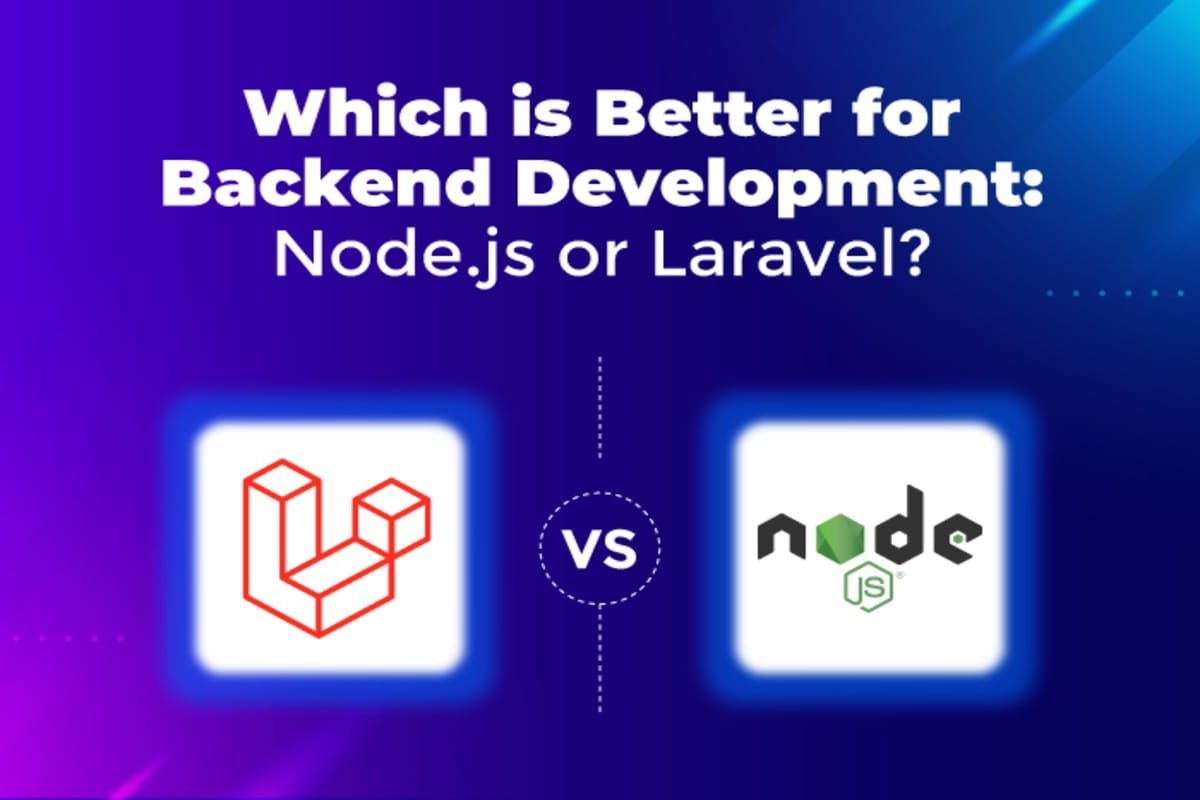When developers build and maintain the server-side of a website or app, it is referred to as backend development. Users aren’t aware of what happens behind the scenes when it comes to backend engineering. To be precise, it encompasses operations like data storage, processing logic, and communication with databases. The objective is to provide a seamless user experience while powering the functionality of an application.
Both Laravel and Node.js are the top choices for web development these days since they both have their strengths and use cases. Even the most experienced developers are in a dilemma about which one to choose. Laravel vs. Node.js—it’s a never-ending battle considering the dynamic requirements of the web development realm.
Being a developer, this blog will give you an in-depth idea about these frameworks and explore the various parameters to help you decide one over on another.
Laravel: A Brief Overview
In simple words, Laravel is a web application framework that simplifies and streamlines the creation of modern PHP applications. It comes with a robust ecosystem that enables developers to tap the potential of Laravel’s built-in capabilities. It isn’t a programming language but more like a set of tools to use PHP.
Developers aiming to leverage the potential of MVC (Model-View-Controller) architecture can go with Laravel without giving it a second thought. This model allows developers to organize code precisely. However, the user interface remains separated from the data management. With Laravel, tasks like routing, sessions, and caching aren’t a big deal for developers. Its elegant syntax and extensive built-in features make this possible.
It offers a comprehensive ecosystem by providing tools and utilities like an ORM system known as Eloquent, the command-line face Artisan, the Blade templating engine, and strong authentication.
Concept of Node.Js
Though most IT professionals and software developers consider Node.js to be a coding language, it is not. Node.js is a runtime environment that holds immense potential and has transformed the realm of web development since its inception. It’s an engine that allows developers to run JavaScript on the server side. It utilizes non-blocking, event-driven architecture, and thereby, surpasses the performance limitations of conventional server-side environments. Node.js is often considered to be the best backend framework for these reasons.
The popularity of Node.js can be attributed to its use of Google’s V8 JavaScript engine. A unique feature of this engine is it allows developers to tackle several tasks simultaneously and efficiently. Developers are building real-time applications with Node.js since instant data processing holds paramount importance in this case.
Top Features of Laravel
Laravel comes with the following features:
- Intuitive ORM: Unlike most other frameworks, Laravel has a very simple and clear-cut syntax. Owing to this characteristic, developers can execute database operations seamlessly. You can use intuitive conventions while working with databases.
- Power-packed features: As mentioned earlier, Laravel has multiple robust features like caching, routing, session handling, and authentication. All the tools coupled with the above features allow developers to adopt an out-of-the-box approach to web development.
- Streamlines intricate tasks: It’s all because of tools like Artisan for command-line tasks and sophisticated ORM for database operations. It plays a great hand in reducing development time while increasing productivity.
- Blade template engine: Blade is the templating engine of Laravel. The main function of this engine is to integrate multiple templates into a data model while producing a comprehensive view. Developers can write clean code that is dynamic at the same time with this robust control structure.
Characteristics of Node.js
The top features of Node.js include:
- Event-driven architecture: Node.js is non-blocking and asynchronous, which is indeed a huge advantage for developers. This JavaScript runtime environment can process several requests simultaneously without blocking other tasks. When it’s Node.js vs Laravel, this feature of the former is bound to give it an upper hand.
- Versatility: Node.js applications offer cross-platform support, which means they can run on different operating systems like Windows, macOS, or Linux. There are no significant modifications required, and eventually, it facilitates extensive reach and easier deployment.
- Active community: The large, and more importantly, active community of developers pertaining to Node.js contributes to a broad ecosystem of modules and packages. It fosters innovation while providing comprehensive support.
- Tackle large data packets efficiently: You can stream any data in Node.js, and it is convenient in every sense. Node.js makes real-time data processing a simple task since it supports both writable and readable streams. Also, it consumes less memory than other runtime environments, which is yet another advantage.
Use Cases and Applications of Laravel
- Content Management Systems (CMS)
- Enterprise applications
- E-commerce platforms
- SaaS products
- Business software tools
Popular Use Cases and Applications of Node.Js
- Chat apps or live streaming platforms
- Single Page Applications (SPAs)
- IoT applications
- APIs and microservices
Differences Between Laravel and Node.js
Both Laravel and Node.js are excellent tools for web development, but the thing is their features are somewhat different. Let’s explore the key differences between them based on the following parameters:
Architecture
Laravel is a traditional PHP framework that adheres to the synchronous execution model. It is MVC-based and can handle one request at a time. There are both benefits and drawbacks of this aspect. The advantage is that it becomes easier for developers to handle extensive codebases. On the contrary, it is unable to handle high concurrency, which deters developers from going with it at times.
Node.js is capable of handling more requests simultaneously because of its non-blocking I/O model. While handling the requests, it doesn’t pose a hindrance to the execution of other tasks. For this reason, developers always prefer Node.js while building applications that demand real-time data processing. For example, live streaming platforms and chat applications.
Verdict: For high-concurrency, real-time applications, you can opt for Node.js. If your objective is to build traditional web applications, Laravel is ideal.
Performance and Speed
While selecting a backend technology, developers can’t ignore performance and speed. However, speed is a trait that’s missing in Laravel. It has a rigid architecture that can tackle both easy and difficult computation-based applications. Along with this feature, Laravel showcases efficiency with database interaction along with heightened security. However, Laravel executes tasks sequentially, unlike Node.js, which results in lower response times. It becomes a huge concern for developers when handling high loads.
As mentioned earlier, Node.js is faster than Laravel, and this is primarily because of its non-blocking cum event-driven architecture. It has the potential to execute multiple operations at the same time. If you want to create an application like real-time communication tools that need quick execution, Node.js will be your call.
Verdict: Node.js provides better performance and speed than Laravel. If you compare Laravel vs Node.js performance, the latter is clearly the winner.
Read also Mastering Arrays in Java: A Complete Beginner’s Guide
Customization
Both Laravel and Node.js are open-source and allow developers to explore customization options. By opting for backend development with Laravel, you get access to the functioning code and enough opportunities for experimentation. If you are acquainted with the intricacies of PHP, modifying these codes as per the app’s specifications won’t be a big hurdle for you.
What’s more, you can provide an authentication system to your application with Laravel Auth and Laravel Breeze. Using Laravel package libraries, you can even alter the appearance and functionality of your backend and frontend application codes.
With Node.js, you can customize the package modules according to development requirements. Developers can manage dependency versions with this runtime environment. You can also modify the boilerplate of Node.js into a functional application and share the same with others. You will have full-fledged control during backend development while getting the scope to choose from frameworks like NestJS, Express.js, or Koa. Nowadays, a large number of organizations are hiring Node.js developers to leverage the potential of this runtime environment.
Verdict: If you aim to build highly customizable applications, Node.js is better suited for the purpose. You can use Laravel for projects where a structured framework facilitates development.
Security
When you focus on security, both Laravel and Node.js are excellent choices. But, there are also certain differences that you need to know. A Laravel project has built-in features like CSRF (Cross-Site Request Forgery) protection, password hashing, SQL injection prevention, and authentication mechanisms.
Node.js also has middleware and security modules that implement encryption and data validation. Despite this fact, it handles asynchronous operations carefully to prevent any sort of vulnerabilities. The thing is that it doesn’t have built-in security features like Laravel. Dealing with security concerns is difficult for developers since they have to go the long route and configure a few things along with third-party modules. Here, the implementation of security best practices is done manually, which is a major inconvenience for developers.
Verdict: For robust security measures, Laravel is a great choice since it has built-in security features. Node.js doesn’t have these characteristics, but you can achieve the same level of security with additional security configurations, and that has to be done manually.
Ecosystem
Laravel has a large user community since numerous developers are building web apps with it. Over the years, it has been growing in popularity due to its multiple features. If a developer faces any difficulty while creating an application, other developers are willing to assist them while sharing their packages. They also mentor and train new developers if needed. Also, several tech giants like LinkedIn, Facebook, and virtual user forums host multiple Laravel user support groups.
Node.js also has a huge number of user forums that provide technical assistance and support to developers. To simplify the task of developers, there is a user community at the official Node website. You can also access a supplemental user support community at the website Nodejs.dev.
Verdict: Laravel has a well-organized community with excellent support for PHP projects. Unlike Laravel, Node.js has a dynamic ecosystem that continuously evolves with web development requirements. This verdict will definitely put an end to your dilemma about whether to use Node.js or Laravel for backend development.
Learning Curve
Developers who are familiar with PHP will find it easy to grasp the technicalities of Laravel. They can bypass the hard work of additional setup since this framework comes with built-in functionalities like database management, routing, and authentication. Moreover, Laravel has well-structured documentation along with multiple learning resources.
Due to network layer variations and asynchronous programming models, Node.js has a steeper learning curve than Laravel. It’s the reason why many inexperienced developers don’t perform backend development with Node.js. You should have a concrete understanding of JavaScript promises and callbacks while handling concurrency effectively. If you master backend architecture along with JavaScript nuances, you can learn Node.js easily.
Verdict: Laravel is good for beginners owing to its organized nature and comprehensive learning resources. With Node.js, you will gain more flexibility, but a strong knowledge of asynchronous programming and JavaScript is required.
FAQs
1. Is Laravel a better choice than Node.js?
Both Laravel and Node.js have their pros and cons. Selecting one over the other depends on your project needs, your team’s skill sets, and the scale of the software application. Laravel is a handy choice for quick development with PHP, while Node.js is perfect for high-performance applications using JavaScript.
2. Is Node.js appropriate for backend development?
Yes, Node.js can implement JavaScript code on the backend of a web application, which eventually opens up new development possibilities. It’s also fast and lightweight, which is yet another advantage.
3. Can I use Node.js to build traditional web applications?
Node.js can be used to serve this objective, but it requires extra libraries and networks for full functionality.
4. Is Laravel perfect for building large-scale applications?
You can use Laravel for this purpose, but more optimizations are needed for high-traffic applications. These optimizations can be caching, database indexing, eliminating unused services, and composer autoloading.
5. Whose security is better—Node.js or Laravel?
Though both have security features, Laravel is preferred due to its built-in security features. On the other hand, Node.js needs manual security implementations.
Bottom Lines
As you can see, both Laravel and Node.js are versatile tools for web development. Laravel is undoubtedly the best choice for structured web applications due to its elegant syntax, rapid development, robust features, and task efficiency. Node.js is good for building real-time applications and high-performance systems that require concurrency. Make sure you focus on project needs, team expertise, and long-term scalability requirements before choosing any of them.







Leave a Reply